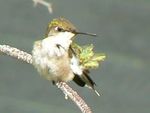WELCOME TO ROBERT J. ROBBINS - VOICE
←
→
Page content transcription
If your browser does not render page correctly, please read the page content below
Vo lu m e 1 7 , N o . 5
T h e S p r i n g t o n L a ke Vi lla g e Ma y 2 0 2 1
VOICE
WELCOME TO ROBERT J. ROBBINS
Robert Robbins moved to Springton in January 2020. Rob was going to move to
Springton from Broomall with his mother, Reina, in November 2019. However, his
mother got sick and died in December 2019.
Rob grew up in Broomall. He moved there at age 2. His father was starting a new busi-
ness, Hi-Fi House, and his mother was pregnant with twins. Hi-fi was brand new at the
time. Rob is the oldest of 4 children.
Rob graduated from Marple Newtown High School and then earned a BA at Villanova.
Following that, he earned a MA in music history at West Chester. Rob did his Master’s thesis on a faculty
member, Ed Zimmer, who was a composer.
Rob worked in the family business, Hi-Fi House, but also put his musical knowledge to use publishing a
quarterly magazine called Big Bands International for 30 years. Rob was the American Secretary. He re-
viewed performances and recordings for the magazine. Rob frequently traveled to England where the
magazine was based. He attended many big band concerts and shows in London while there.
Rob’s father had a lot of jazz records in the store which led to Rob’s interest in jazz, starting at
age nine. Rob is a member of the Tri-State Jazz Society which gave monthly jazz concerts alternating be-
tween the Wallingford community art center and Haddonfield before the pandemic. Rob produced infor-
mation sheets about the performers for the concerts . He also wrote about jazz for the Broad Street Re-
view, an online publication. Rob is an excellent writer. You can read some of his articles online.
The Tri-State Jazz Society will be live streaming from New Orleans next month and Rob will be
there. Currently he is working on an information sheet about the singer who will be live streamed from
New Orleans. A month before the pandemic, Rob took a jazz cruise. There were jazz groups performing
throughout the ship almost 24/7.
Rob comes from a musical family. His grandfather, as a child, sang in Yiddish theater with Molly Picon.
Rob’s grandfather gave Rob‘s mother a Steinway piano which Rob brought to Springton. Rob took lessons
but didn’t continue although the piano is still a large presence in his life.
David, Rob’s next brother, is an attorney and loves classical music. His sister Edna loves musical thea-
ter. Jon, the youngest, loves music of the 70s and 80s. Jon sells electronics wholesale online. (Home The-
ater Specialists of America) Rob has many nieces and nephews.
Rob has had dogs as pets. He wrote about one named Droodles for the Village Voice. The family had dogs
named Renault and Peugeot, the names inspired by a family trip to France.
Rob is very happy with his move to Springton. He particularly appreciates the landscaping care and the
meals. Rob has an electric grill and enjoys grilling out on his driveway. Rob is quiet and unassuming but
he has done a lot. After this interview and especially after reading some of his articles, I felt I should have
asked him to write it but he didn’t want to brag! Welcome, Rob.Page 2 Volume 17, No. 5
RUBY THROATED HUMMINGBIRDS
The Ruby throated Hummingbirds (Archilochus colubris) are
back. Ruby throats are the only hummingbird in the eastern
United States except for rare reports of Rufous Humming-
birds. Male and female are similar but the female lacks the
sparkling scarlet gorget or throat patch. Ruby throats winter
in Central America and arrive in North America in late March,
and in our area in early to mid April. Hummingbirds can hover Male
Female in one place, fly forwards and backwards and upside down.
Hummingbirds are very territorial and guard their food sources vigorously. You can hear the
body blocks when they slam into each other. Less dominant hummingbirds have to settle for
unguarded flowers or sneak in to grab a drink from a feeder. (The more feeders the better!)
The bill and long tongue allows them to probe deep into flowers for nectar, but also to preen,
catch insects and attack other hummingbirds. Normal body temperature ranges from 104 to
110 degrees, but at night it is about 70 degrees. If the nights are extremely cold, the humming-
bird can enter torpor by lowering its breathing, heart rate and metabolism. Hummingbirds have
the most rapid metabolism of all birds and eat the most food, relative to body weight, of any ver-
tebrate. Adaptations for flight and weight reduction include – rapid transit of food through the
digestive system (not stored), only one ovary, hollow bones, and air sacs throughout the body
which connect with the lungs. Hummingbirds, like most birds have a poor sense of smell and
are attracted to flowers by color.
Their wings beat about 52 times a second, but in the nuptial dive, 200 times a second. The fe-
male makes a nest and then finds a mate. The male does a courtship display of deep J shaped
aerial dives. Then he does a shuttle flight which involves swinging back and forth several times.
After mating, two eggs are laid, usually two days apart, and the female incubates them and
feeds the chicks with no help from the male. The eggs hatch in 15-22 days. The
mother feeds them regurgitated nectar and insects. Ruby throated humming-
bird chicks may stay up to 31 days in the nest. Chicks can
fly well when they leave the nest, but may have trouble
ü - landing. You can tell the younger hummingbirds at the
ü feeder because their bills are a little shorter than the
adults’. Nest
ü
- Hummingbirds eat 50% of their weight in sugar every day, feeding 5 to 8
ü - times an hour. The Ruby throat normally has about 13% fat in the liver.
— Before migration the level of fat reaches 41 – 46% to supply fuel for the
500 mile nonstop migratory flight across the Gulf of Mexico in October.
ü - What a remarkable jewel!
Put your hummingbird feeders out early in the month. The birds need food
ü
on their way further north, and not many flowers are blooming yet. To
make the food, boil 1 cup of water and add 1/4 cup of granulated sugar
ü
(or any other quantity that has the ration of 1 part sugar to 4 parts water).
Do NOT add food coloring. You can keep the unused portion in the refrig-
ü
erator in a closed container. Change the food every 4 days or more often
in hotter weather.VOICE Page 3
THE HUMMINGBIRD TONGUE
New findings on how Hummingbirds drink nectar:
Hummingbirds have forked tongues and were
thought to collect nectar by capillary action Lamellae
(where liquid rises against gravity in a narrow
tube.
Recently, using high speed cameras (500 Tongue
frames a second) and see-through flowers, a
team from the University of Connecticut has
proved that theory wrong. Tip of Beak
The hummingbird’s forked tongue is lined
with hair-like extensions or fringes called la-
mellae. When inside the flower, the tongue separates and the lamella extend outward. As the bird pulls
its tongue in, the tips come together and the lamellae roll inward, trapping the nectar within the tongue.
This very efficient process is a function of the structure of the tongue and requires no energy expenditure
by the hummingbird. Now the researchers need to figure out how the hummingbirds are able to swallow
so quickly since the tongue can flick into nectar as often as 20 times a second.
JULIETS’ LUNCH ON THE PATIO
L to R: Jane Corson, Patty Billings, Sally Parker, Joyce Walsh, Lora Jo Dickhart, Joanne Dalton, Patti Calderoni,
Naomi Pliskow and Louisa Ridgway enjoy the first Juliets’ lunch since the pandemic began.
Back: Marge Gillis (hidden), Joyce Meyers, Suzanne Peters, Kathy Will and Gloria Detwiler.
Front : Eileen Spinelli, Carmela Patterson-Mooney, Shirley Coletti and Betty KearneyT h e S p r i n gt o n L a ke SPRINGTON LAKE VILLAGE
V il l a g e V o ic e
M a rt i na M a rt i n, Edi t or “Leading the way in creative 55+ housing”
Springton Lake Village is a cooperative community of 40 residences for individuals and
couples, 55 or older, established in 2002. Upscale and independent, with a neighborhood
feel, no additional residences will ever be built. There are no entrance fees. Equity owner-
ship assures members a say in how the community is run.
It is located in Marple Township, Delaware County, Pennsylvania, and is operated by
101 Longview Circle
Media, PA 19063-2075 Springton Housing Association Cooperative , Inc., a non-profit corporation owned by the
residents. The Village is convenient to Philadelphia’s Main Line and the cultural, recrea-
tional and sports attractions of one of America’s great cities.
We’re on the Web! Ridley Creek State Park and Tyler Arboretum are close by, as are Delaware County’s finest
springtonlakevillage.com country clubs. There is convenient access to Interstate 476 and U.S. Route 1.
Our waterfront community features the serenity of Springton Lake and its half mile of pris-
tine shoreline. Residents enjoy peaceful woods, clean air, open skies, beautiful sunsets, a
walking path that winds through the property, a fitness center, and a flexible dining plan
four nights a week in the multi-purpose Clubhouse.
Springton is associated with nearby Dunwoody Village and White Horse Village, acclaimed
and accredited continuing care retirement communities with long term care facilities.
5/1 Doris Ficca
5/5 Sally Parker
5/25 Kate Perry
5/27 John Wagner
MANAGEMENT REPORT
Welcome to our newest resident: Patricia
Calderoni. We are delighted you are here!
Mike and Carmen continue to get the Com-
munity in shape for the Summer season.
Don’t fret if your deck and deck furniture
hasn’t been addressed. The Clubhouse
doors are unlocked during normal business
hours. No need to remember your access
card. The new Clubhouse office phone sys-
tem still has some issues to work out, but
all in all it is functioning as expected. As al-
ways, call or email the office with your
workorder requests.You can also read
























































